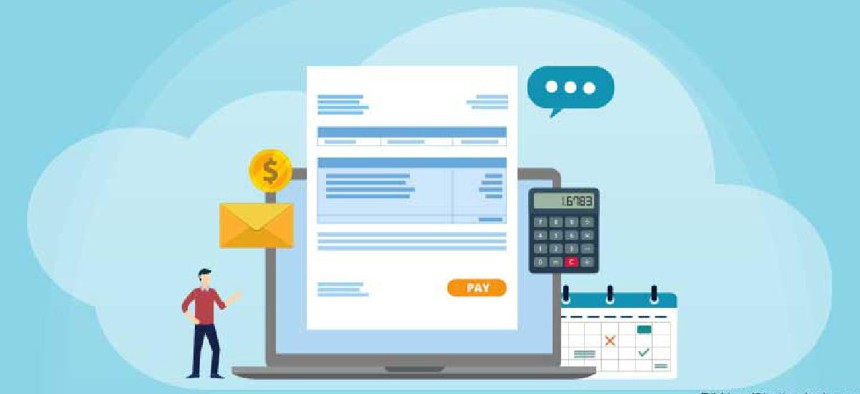Ushering in the future of government pay


Connecting state and local government leaders
NewPay enables mobile processes, unprecedented data analytics and many other 21st-century features.
There is a quiet revolution occurring in the world of federal payroll. This modernization started with the adoption of commercial off-the-shelf (COTS) payroll, work schedule and leave management solutions, specifically for NewPay, which is bringing government pay processes into the modern era.
NewPay is a federal initiative designed to modernize payroll as well as work schedule and leave management services. It harnesses the efficiency, power and standardization widely used in the private sector to deliver streamlined processes. Deployed in the cloud as out-of-the-box, software-as-a-service solutions, NewPay enables mobile processes, unprecedented data analytics and many other 21st-century features.
The NewPay effort was initiated by the Office of Management and Budget in collaboration with private-sector technology experts. The initiative aims to eliminate the high operation and maintenance costs of supporting the legacy Cobol systems currently used by the government's payroll shared service providers: the Defense Finance and Accounting Services, National Finance Center, Interior Business Center and General Services Administration.
As part of the Sharing Quality Services Cross-Agency Priority Goal under the President’s Management Agenda, the effort is expected to save the government up to 30% in costs. However -- and this is the revolutionary part -- for the first time, the government has incorporated a COTS solution for payroll service providers to calculate pay and deductions, setting the stage for modern technology to drive innovation and increase efficiencies across the government.
The power of one
NewPay is replacing four separate antiquated federal payroll systems (down from 26 systems a decade ago), each built and designed prior to the internet. The old systems -- some even predating PCs -- operate on space-hogging, energy-inefficient legacy mainframes and feature processes largely based on paper, manual entry and redundant information maintained across functions and locations.
The first NewPay task order under the 10-year blanket purchase agreement contract was awarded in September 2019 and aims to give the shared service providers a path to retire their legacy systems over the next decade. NewPay offers the opportunity to automate standard business processes and streamline processing through application programming interfaces (APIs) and data schemas that support data exchanges and reporting.
The new initiative also is set up to address increasingly complex human resources and workforce management issues, while also building value by offering functionality such as employee self-service. NewPay integrates data across all functions, providing transparency and real-time access to staff and leadership, thus reducing the risk of downtime or data loss in case of an emergency. The SaaS solution will help eliminate low-value activities, such as manual inputs and multiple reconciliations, allowing staff to focus on core mission priorities while improving the user experience and service.
The time is right
While some may consider the NewPay effort long overdue, the government was not able to leverage an off-the-shelf system until now because the required range of functionality did not exist. NewPay is only possible today because of the recent, rapid evolution of cloud computing and collective entities working together to streamline data mapping and processes.
While many eyes are on the technology that powers NewPay, it should also be noted that another crucial benefit of transitioning payroll into currently available COTS programs is the ability to relieve today’s recruiting and staffing pressures. It is estimated that nearly 1.5 in 10 federal employees are eligible to retire now, with that number expected to grow to 3 in 10 employees in 10 years. The knowledge needed to operate and configure legacy payroll systems will not be readily available when IT professionals are focused on current and emerging technologies.
With the move to the COTS solution, government will be better able to recruit top technology staff, attract talent that may otherwise turn to the private sector and modernize the larger workforce to build toward the future. Many of today’s graduates are prioritizing jobs that give them purpose, value and the ability to change and be innovative. The digital revolution has created a worker expectation for constant mobility, in career movement as well as daily responsibilities and workflow. NewPay makes those opportunities possible in the public sector.
What’s more, cloud deployment removes tasks that add less value, such as back-up responsibilities, bringing efficiencies to systems processing.
NewPay also removes risk from its revolutionary approach. While the system creates more connectivity and data sharing, it is also a certified secure SaaS application, complying with the Federal Risk and Authorization Management Program’s strict federal security standards.
While NewPay implementation is just getting underway, a dedicated team is working diligently to ensure the rollout will be configurable, scalable and repeatable for federal agencies ready to embrace the off-the shelf revolution. It’s the beginning of a careful and strategic shift, but one that will have an important and growing impact far into the future.




